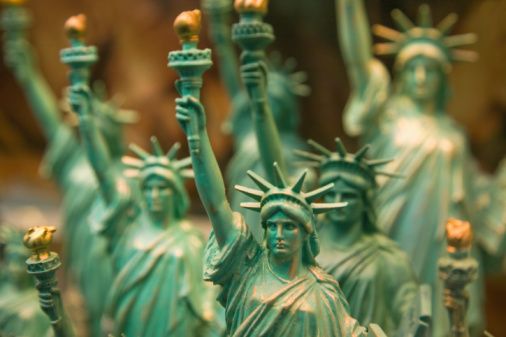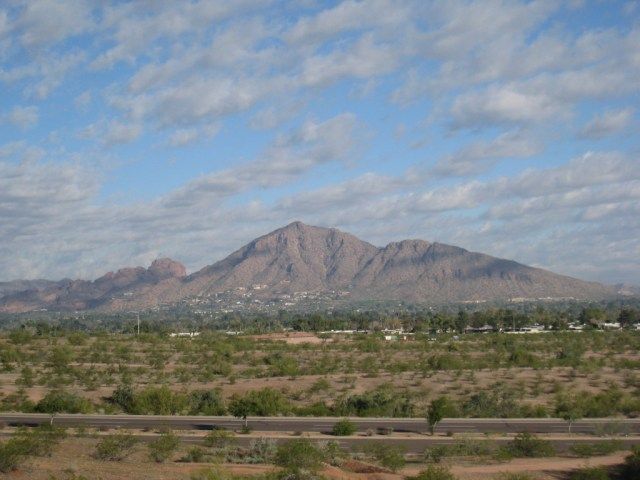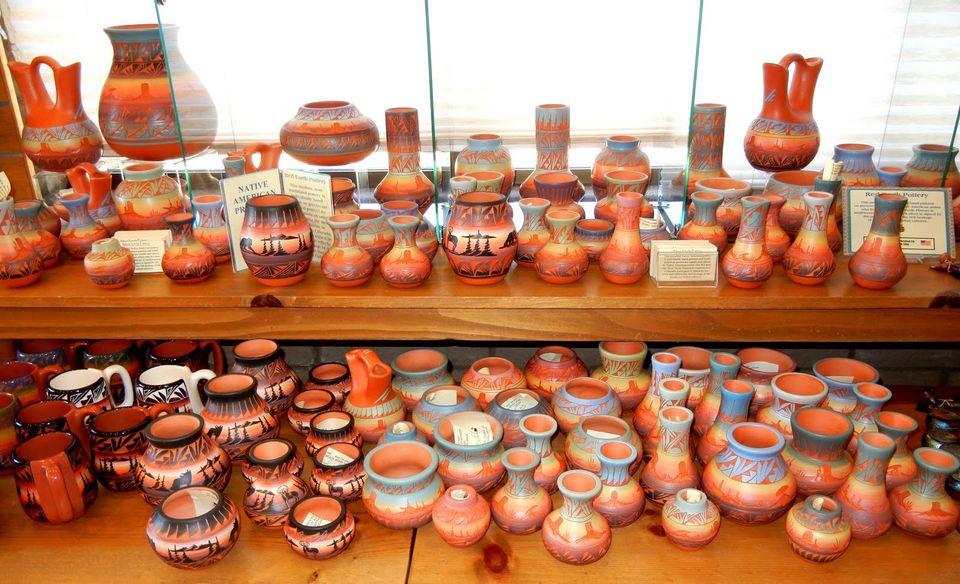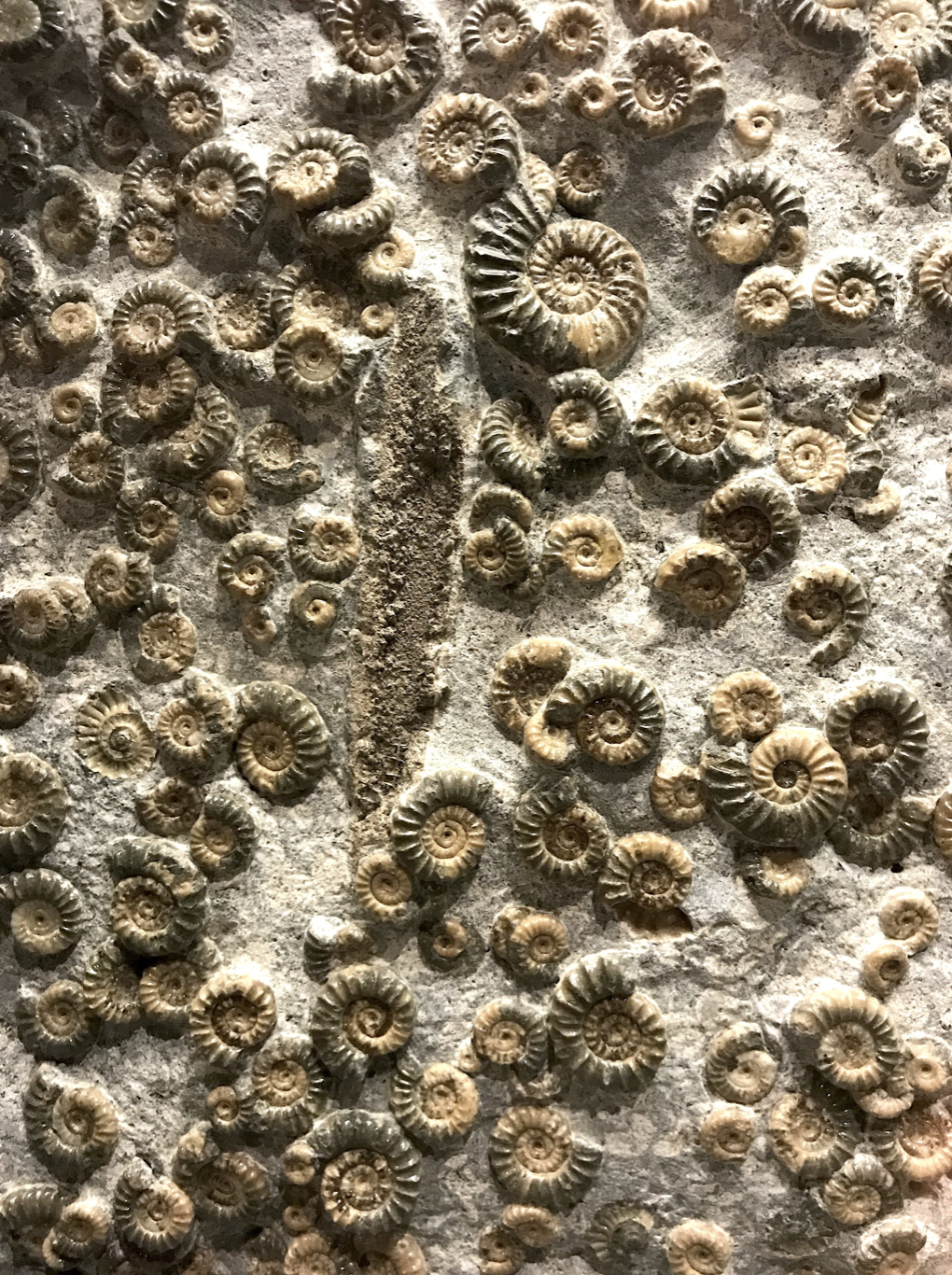A writer walks through a suburb of a desert city. He finds that art,souvenirs , tradition, memory, and dam-building and citrus trees have something to do with each other. This is the second of five essays.
The city of Phoenix is a grid, like New York, within a mountain-rimming bowl—the valley of the sun. Here, one block is a square mile. The road I’m on splits into Scottsdale Boulevard and Drinkwater Boulevard. Drinkwater was the real, and as best as I can tell, original last name of the once-mayor of Scottsdale, Herb Drinkwater. There is a statue of him in Scottsdale near the Civic Center, with a dog at his side, wagging his brass tail. The mayor wears a Stetson, bow tie, and a big smile. It’s the best job in the world to serve the people of Scottsdale, the monument says.
Scottsdale Blvd., running north-south, divides art and craft. No art shops there, no souvenir shops here. Crossing over, I took out a cigarillo – it seemed the right western thing to do – and haunted the souvenir side of town. At an un-manned covered wagon I find pamphlets about nightlife and informationals about the best burgers, all sorts of maps. I stuffed these into my satchel.
With over one hundred art galleries and over sixty shops, I wondered if there were as many stores so densely put in a New York street and I had never noticed it before. In Midtown, for instance, there are souvenir shops but they are cushioned by the more numerous brand name shops. Carrying across the U.S. to Scottsdale, every souvenir shop invariably has this aesthetic. You notice the lights inside the shop first. It didn’t matter if it was sunny outside. From vaulted ceilings, the light didn’t shine, it weightlessly fell. The light has to be described that way. To shine the light needs direction, velocity, linearity. But the light was diffuse, massless, coating things like an invisible fog.
In New York I once watched a family walk into one of these stores. The first thing they see are racks, with t-shirts and other apparel, arranged to make deep trails. The father is looking for something to commemorate their trip to the southwest. The kids look at what’s at eye-level: snow globes, shot glasses with funny quotes, mugs, miniature Statue-of-Libertys, postcards. The mother wants to get a tiny token to send to their parents. The kids like stuffed animals. The father settles on a key-chain, a stuffed-python the kids will fight over in the backseat, an oversized t-shirt, and a little Empire State Building as a gift for the in-laws.

This same experience transposes onto every shop in Scottsdale, using this simple function: mugs laminated with names w/ [insert Scottsdale scenic shot] + shot glasses laminated or decorated with [insert cacti or local pun] + t-shirts laminated with [insert date: time: event/place] + click pens with [insert local motto or slogan] + … + 1n-1 + 1n. The very same souvenirs found in New York were here. The only difference was the plastic mold used to make them. Gift shops carried Scottsdale-specific t-shirts. Different in font, color, and slightly in wording, but they all said the same thing, to the algorithmic product.
In one jewelry shop window is a necklace I had seen in a previous shop, the same peculiar design of a dancing man playing a flute. There were loads of pretty turquoise necklaces—albeit, the designs did repeat after a while, like a suburban neighborhood. Some were hand made. Others were genuine. Others still were antique or traditional. None were unprofessional or shabby.
The figure I kept seeing was, I later found out, called the Kokopelli. Some date his beginnings at 700 A.D., carved onto mountain faces and inside caves. For the Hopi, a southwestern tribe, and a few others, the Kokopelli is the demiurge of fertility and harvest. He plays the flute, has spiked, long hair, a skinny figure wearing a robe. I saw his figure engraved into pendants, necklaces, every species of jewelry. One version of his history holds that strangers would walk into tribes, playing the flute and dancing, and by this the tribe knew that the Kokopelli had come to tell tales, trade, and speak prophecy and prayers over their crops. This wasn’t the only symbol on necklaces. There were others, all drawing their meaning from near-ancient sources.
The pamphlets gave recommendations for those who want authentic Indian art, recommending buyers ask for a certificate to prove that the piece was made by the Navajo or whichever tribe. The pieces tend to be expensive. That’s part of their authenticity, being craft not product. Especially the rings and bracelets; the hammer work shows its telltale in-congruency.

The Navajo wore jewelry less than all this makes believe. The tables and the shops, lined with sterling silver jewelry, give an image that the Navajo wore an excessive amount of jewelry. But historically, jewelry was rare and ceremonial and pottery was mundanely practical. Making so much, and so much of, the jewelry and pottery gives the wrong impression. This jewelry is made by the Navajo, but not for the Navajo. More people want Navajo jewelry than the Navajo did.
These souvenirs provided the sense that they were for those just passing through, like when visiting a mountain you leave with a rock to show you were there. This is the transformation from museum piece to souvenir. Museums take artifacts and instead of using them, use them to reveal the past to us. But those artifacts – pottery, ceremonial necklaces, dream-catchers, pipes, baskets – were made, originally, to be used. That’s what makes them real. But when they’re made for the museum of your home (i.e., not used) they’re no longer museum pieces; something is absent.
So too the blanket that is hard to sleep in because of the monogrammed “Grand Canyon, 1999” thickly sewn on it’s corner and the equally uncomfortable pillow with “Appalachian Trail, 1997” in wild-west font; the millions of monuments minimized into miniatures. The grandeur, spontaneity, indescribability “you had to be there” of a place, of a history, of Michelangelo’s David, is reduced to something you can pack away and then put on a shelf. It appears that nothing cannot be shrunk—the miniaturized Pieta, the Ecstasy of St. Teresa, every bit of national architecture. Monuments and histories are taken to foreign countries, unknown coffee tables and kitchens, set next to a dozen other statues and mountains. The monumental is made a mantelpiece, mutatis mutandis. The mountain’s timelessness is taken rock by rock by those who want a part of its grandeur. Like Moses taking tablets from the mountain, they are tangible testaments of a place, a terra. Nothing can be taken too seriously that fits in a pocket.

“Souvenir” can refer to many things, and I was having trouble, walking around at 8:30, to decide on what it meant in Scottsdale’s case. The souvenirs were forces of unseriousness yet nonetheless carried the power of what they were formed after. This other part was, after thinking a little longer, the more obvious point: they’re for remembering. “The mountain was made of this,” one says, holding up a piece of shale.




